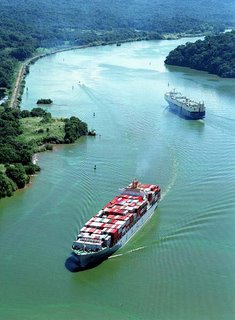
The Panama Canal bisects the continents of North and South America, cutting through the isthmus of Panama, and connecting the Atlantic and Pacific Oceans in Central America. The canal, whose building was one of the largest and most difficult engineering projects ever undertaken, has a huge impact on shipping, as it removes the need for ships to travel the long and treacherous route via the Drake Passage and Cape Horn at the southernmost tip of South America. A ship sailing from New York to San Francisco via the Panama Canal travels a distance of 5,264 miles (8,472 km), a savings of more than 7,800 miles (12,500 km) — or approximately 20 days — over the 13,100 mile (21,000 km) route around Cape Horn.
Although the concept of a canal in Panama dates back to the early 1500s, the first attempt to construct a canal began in 1880, under French leadership. The building of the 51 mile (82 km) canal was plagued by problems, including disease (particularly malaria and yellow fever), and massive landslides. The work was finally completed by the United States, and the canal opened in 1914.
The canal has been enormously successful, and continues to be a key factor in world shipping. Each year the canal accommodates the passage of over 14,000 ships, carrying over 203 million tonnes of cargo. Approximately 800,000 ships have passed through the Panama Canal since its completion
No comments:
Post a Comment